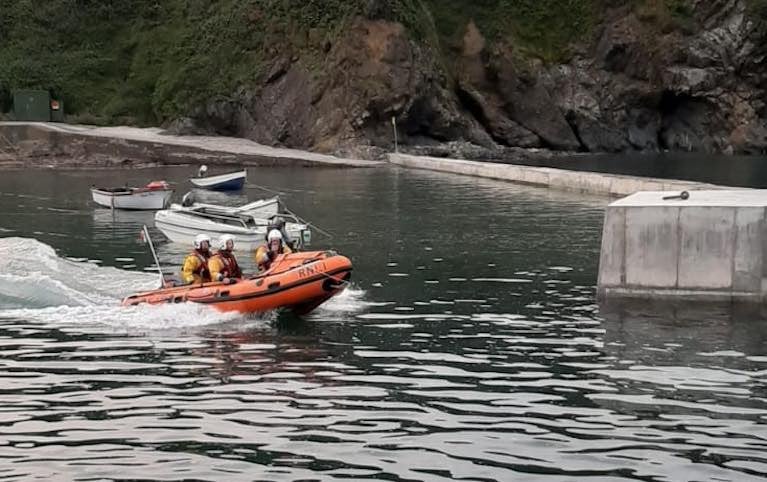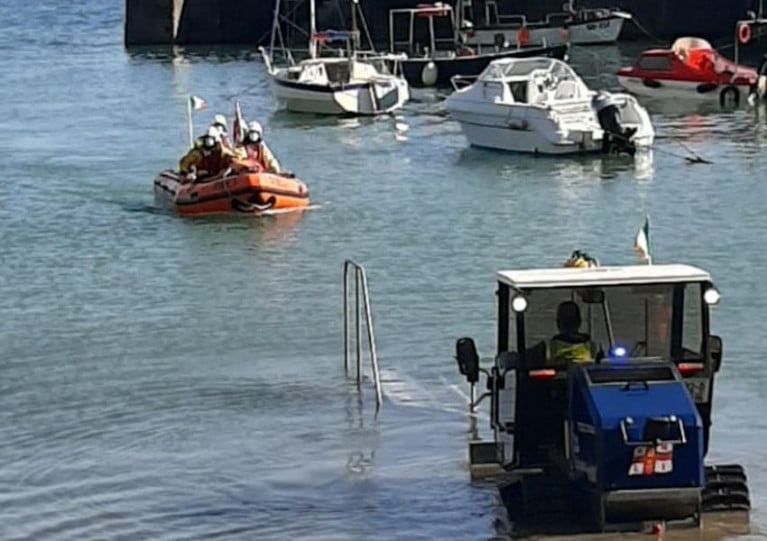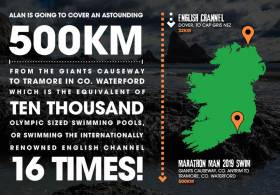Displaying items by tag: Tramore
Tramore RNLI went to the aid of one person on a pleasure boat with engine failure last Thursday evening (18 January) in the Co Waterford crew’s first call-out of 2024.
An emergency call received by the Marine Rescue Co-ordinating Centre (MRCC) from a stranded half-decker pleasure boat in Tramore Bay saw the volunteer lifeboat crew called into action.
The single occupant of the pleasure boat had raised the alarm on their mobile phone to say they had engine failure about a kilometre from Tramore Beach.
Helmed by Fergal McGrath and crewed by Peter Kelly and Kevin Lehane, the inshore lifeboat was launched shortly after they were paged at 4.45pm, and they were on scene within two minutes.
It emerged that the casualty vessel had lost engine power and was drifting towards the beach. The crew assessed the situation and decided to tow the broken-down boat to Tramore Pier, where it was tied alongside at 5.15pm.
Speaking following the call-out, Tramore RNLI helm Fergal McGrath said: “Well done to the casualty, they did the right thing in calling for help as soon as they felt they were in trouble and we were delighted to help.
“We would encourage anyone planning a trip to sea to always go prepared, always wear a lifejacket and always carry a means of communication. Should you get into difficulty, call 999 or 112 and ask for the coastguard.”
Tramore RNLI were involved in the rescue of two swimmers who got into difficulty off Tramore Beach on Friday evening (9 June).
The volunteer crew were requested to launch their inshore lifeboat at the request of the Irish Coast Guard following a call from a family member stating that her mother and brother were in difficulty off the Ladies slip in Tramore.
Pagers alerted the crew at 5.37pm and the D-class lifeboat — helmed by Dave O’Hanolan and with crew members Ronan McConnell, Noirin Phelan and Will Palmer onboard — launched minutes later at 5.42pm and made its way to the casualties reported position.
Weather conditions at the time were described as sunny and warm with two to three feet of surf and a brisk east to northeasterly wind.
On arrival, the lifeboat crew observed both casualties in the water with the male casualty keeping the female afloat. The mother and son had got caught in a rip current while swimming.
As they were close to the beach, two members of the public who spotted the pair in difficulty had gone into the water with a life ring and assisted in the recovery of the man while the woman was subsequently rescued by the lifeboat crew.
The Waterford-based Irish Coast Guard helicopter Rescue 117, which was on exercise just minutes away, attended and their winchman — a paramedic — was lowered onto the beach to assess the casualties. Both were found to be shaken but otherwise safe.
Speaking following the callout, Tramore RNLI helm Dave O’Hanolan said: “Time was of the essence this evening and we would commend the family member who raised the alarm and the members of the public who with safety in mind first, used a life ring before entering the water. The efforts of everyone this evening resulted in a life saved.
“As we continue to enjoy some good weather, we would encourage anyone planning a trip to the coast or an activity at sea to always go prepared by wearing a lifejacket or suitable flotation device and to always carry a means of communication.
“For swimmers or anyone getting into the water, we would remind people that rip currents can be difficult to spot but are sometimes identified by a channel of churning choppy water on the sea’s surface. Even the most experienced beachgoers can be caught out by rips.
“The best way to avoid them is to choose a lifeguarded beach and to always swim between the red and yellow flags which have been marked based on where is safer to swim in the current conditions. This also helps you to be spotted more easily should something go wrong.
“If you do find yourself caught in a rip, don’t try to swim against it or you will get exhausted. If you can stand, wade don’t swim. If you can, swim parallel to the shore until free of the rip and then head for shore or raise your hand and shout for help.”
Waterford Council Criticised for Use of Bleach to Sanitise Streams Near Dunmore East and Tramore Beaches
Waterford City and County Council has been criticised for its use of bleach to disinfect streams that enter the sea near two popular coastal bathing areas, as TheJournal.ie reports.
The council says it uses sodium hypochlorite to sanitise streams near beaches at Dunmore East and Tramore during the summer bathing season, citing the prevalence of children playing in the waters.
But the chemical compound is considered harmful to flora and fauna by various State agencies, with NGOs like Coastwatch Ireland also expressing their concern.
TheJournal.ie has much more on the story HERE.
As Afloat reported on August 16th, Inland Fisheries Ireland (IFI) says it is investigating the “very concerning” claim.
Tramore RNLI Go to the Aid of a Group of Kayakers in Difficulty
Tramore RNLI were on a training exercise on Saturday afternoon (23 April) when they were tasked by MRCC and redirected to assist a group of kayakers in difficulty.
Upon arrival at the scene minutes later, the crew learned that the men involved were a party of five who were attempting to return to Newtown Cove having paddled out to Great Newtown Head. When they realised the conditions were far from favourable they turned and tried to battle against strong wind and considerable chop.
A number of the group capsized and this accelerated the onset of hypothermia.
Three men were recovered into the lifeboat and brought directly to the RNLI boathouse at the Pier for medical attention. The remaining two of the party made it safely to Newtown Cove where they were assisted by Tramore Coastguard Unit.
On return to the safety of the boathouse, two of the men were treated for mild hypothermia while another was treated by paramedics and transferred to University Hospital Waterford for further assessment and treatment.
Strong offshore winds contributed to the difficulty encountered by the group.
Tramore Sea Rescue Association (CRBI) lifeboat also launched to assist in the rescue and recovered the kayaks that had been abandoned.
The speed of the response and the positive outcome was helped by the prompt reaction of a member of the public who was concerned about the group's lack of progress in the conditions.
This was a great interagency response example from Tramore Lifeboat RNLI, Tramore Coastguard, Tramore Sea Rescue Association (CRBI), National Ambulance Service and Rescue 117.
Tramore RNLI Recover Swimmer in Difficulty
The crew of Tramore RNLI and Tramore Coastguard in County Waterford were tasked to assist a swimmer in difficulty this afternoon close to the Guillamene Cove.
The swimmer was rescued from the rocks by the RNLI crew and brought immediately to Tramore Lifeboat Station.
The casualty was then transferred to the care of paramedics from Waterford Ambulance and Dr Matthew Sills.
Tramore Lifeboat Rescues Swimmer In Difficulty
Tramore RNLI’s lifeboat volunteers were tasked to the aid of a female swimmer in difficulty at the Guillamene cove in Co Waterford yesterday afternoon (Sunday 27 September).
The inshore lifeboat was lunched at 1.55pm and within eight minutes was at the scene, where three people had been swimming near the rocks.
Easily identifiable by her yellow swimming hat, as WLR FM reports, the casualty had suffered a cramp and her companions swam back to shore to raise the alarm.
The woman was recovered from the water and on further medical attention was necessary.
Fergal McGrath, one of the helms at Tramore RNLI, said later: “This was our 23rd shout this year, making it our busiest year to date.”
‘Marathon Man’ To Take On 500km Charity Swimming Challenge From Causeway Coast To Tramore
This summer, Waterford’s ‘marathon man’ will attempt a 500km open water swimming challenge from the Causeway Coast to Tramore to raise funds for stroke and cancer support.
Alan Corcoran made headlines in 2012 when be became the first man to run a lap of the island of Ireland in tribute to his father, former FAI president Milo Corcoran, who suffered a stroke the year before.
After his father’s death from cancer in 2016, Alan embarked on another ambitious undertaking — to swim from the top to the bottom of Ireland.
Alan first attempted the swim in 2017, but came acropper some 200km in when his support boat sank to shy of the border.
Nevertheless, his efforts still raised €13,000 for his chosen charities, and firmed his resolve to take on the challenge again in aid of the Irish Heart Foundation and Solas Cancer Support Centre.
“Losing my dad has been the toughest experience of my life,” says Alan. “Out of the darkness I am determined to grasp any opportunity to create some positives.”
He adds: “The swim is my small way of feeling like I’m taking some meaningful action.”
As Alan prepares to set out from the Giant’s Causeway on Saturday 1 June, he is also seeking a skipper to sail his 32ft Jeanneau Attalia as a support vessel for the swimming challenge. For more details see the Afloat Marine Market HERE.
#CoastalNotes - The Canadian coastguard hat found washed up on a Co Waterford beach before Christmas may have been traced to Newfoundland, according to CBC News.
As previously reported on Afloat.ie, Tramore man Craig Butler found the barnacle-encrusted hat while returning from surfing at a local beach on Christmas Eve.
Upon searching the internet for the Latin inscription on the hat, he discovered that it belonged to the Canadian Coast Guard – which has now confirmed that it would be been worn by an officer of its environmental response unit.
It also said that accounting for prevailing winds and currents, the hat most likely entered the water in the Canadian Coast Guard's Atlantic Region, which encompassed the Maritimes and Newfoundland.
CBC News has more on the story HERE.
Canadian Coast Guard Hard Hat Washes Up In Tramore
#CoastalNotes - Just weeks after a US Coast Guard life ring was found on the Clare coast comes news that a hard had belonging to the Canadian Coast Guard washed up in Tramore on the South Coast.
As CBC News reports, the barnacle-encrusted hat was discovered on Christmas Eve in the Co Waterford coastal town by local man Craig Butler, who left it on a sea wall due to its noxious odour.
But the surfer later searched online or the Latin inscription on the hat, 'Saluti Primum Auxilio Semper' – the motto of the Canadian Coast Guard, which translates as 'Safety First, Service Always'.
It's not yet known how old the hat is or how it might have ended up in the sea, nor whether it travelled as far as the 6,000km the life ring found in Kilkee some weeks ago had drifted from Florida more than two years ago, as previously reported on Afloat.ie.
CBC News has more on the story HERE.
Tramore RNLI Name New D-Class Lifeboat 'Isabella Purchase'
Tramore RNLI officially named their new D-class lifeboat Isabella Purchase during a ceremony at the National Lifeguard Training Centre in Tramore on Saturday. The honour of naming the new lifeboat went to Mrs Sally Mongey, wife of the late Finn Mongey. Finn was the Lifeboat Operations Manager for Tramore RNLI Lifeboat Station from when it re-opened in 1964 until his retirement in 1984.
The lifeboat was named in honour of Mrs. Ivy Purchase, who was known as Isabella, and who died in September 2012, leaving her estate to the Royal National Lifeboat Institution (RNLI) to provide a lifeboat in her name. She lived in Midhurst, West Sussex and was a long-time supporter of the charity. The new lifeboat, which has already launched four times on service since its arrival, replaces the Trá Mhór lifeboat, which was placed on service on 30 June 2005 and launched 127 times, rescuing 100 people, over its lifetime.
Tramore RNLI was the first Irish lifeboat station to receive the original of the D-class lifeboats in 1964. They were specially developed by the RNLI for inshore rescues carried out close to land and hard to access areas.
The D-class lifeboat is built at a cost of €62,000 and has been the workhouse of the charity for nearly 50 years. It is inflatable, robust and highly manoeuvrable, capable of operating much closer to the shore than the all-weather lifeboats. It is especially suited to surf, shallow water and confined locations, often close to cliffs, among rocks or caves. It measures five-metres in length and can carry three crewmembers on board. It has an endurance of three hours at sea, at its maximum speed of 25 knots.
Peter Crowley of the RNLI Irish Council accepted the lifeboat on behalf of the Institution before handing her over into the care of Tramore Lifeboat Station. Speaking during the handover he said,
‘As marine leisure activity around our coast increases, the demand for our rescue services grows in tandem with this increased activity. In Tramore the station’s lifeboat crew have rescued a total of 54 people in the last five years. One can only imagine the life changing impact of these rescues on both the casualties and the volunteer crew members who performed them. I thank you for your invaluable contribution and I am in awe of your selflessness and dedication.’
Mrs. Sally Mongey, wife of former Tramore RNLI Lifeboat Operations Manager Finn Mongey officially names the station’s new D-class lifeboat ‘Isabella Purchase’ assisted by the station’s current Lifeboat Operations Manager Derek Musgrave
‘Every naming ceremony for a new lifeboat is a special occasion and today we are honouring Mrs. Isabella Purchase and her generous life-saving gift to the Institution and the people of Tramore.
‘We couldn’t operate our lifeboat without the dedication of our volunteers. The crew in Tramore provide an outstanding service to their community. There is nothing greater that a person could offer and they deserve nothing less than the best in lifeboats, equipment and training that the RNLI offers. May our lifeboat crew come home safely in the Isabella Purchase and may they bring many home to safety.’
Among the platform party at the service were Mr. Len Bell, Chairman of Tramore Lifeboat Station who welcomed guests and opened proceedings; Peter Crowley, RNLI Irish Council member who accepted the lifeboat on behalf of the RNLI and handed her into the care of the station; Derek Musgrave, Tramore RNLI Lifeboat Operations Manager, who accepted the lifeboat on behalf of the station; Frank Nolan, President of the Tramore Lifeboat Station, who proposed the Vote of Thanks and Mrs Sally Mongey, who officially named the lifeboat.
Fr. Shane O’Neill and The Very Reverend Maria Janssen lead the Service of Dedication and music was provided by the Doirdan Male Choral Ensemble, Mr. Damien Kehoe, Mrs Claire Musgrave and Mrs. Cecelia Kehoe.
In a special moment during the ceremony three of Tramore RNLI’s volunteer lifeboat crew received their Long Service Badges and Certificates for 20 years’ service to the life-saving charity. They were Raymond Cowman, Brian Kavanagh and Stephen Murray.
Tramore RNLI has a proud and distinguished record in the RNLI, receiving 13 Silver Medals for Gallantry and the Thanks of the Institution Inscribed on Vellum on five separate occasions. The lifeboat station was opened in 1824 with the first lifeboat rowed by a crew of eight lifeboat men. The station closed in 1924 but was reopened again in 1964 with a D-class lifeboat; this class of lifeboat has been on service since then with improvements made to successive lifeboats.































































